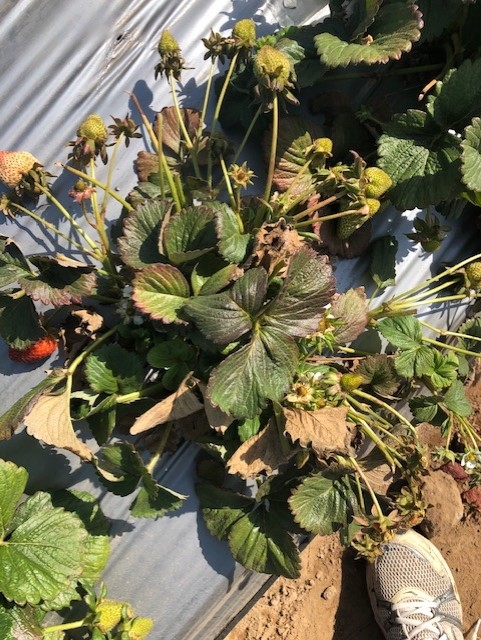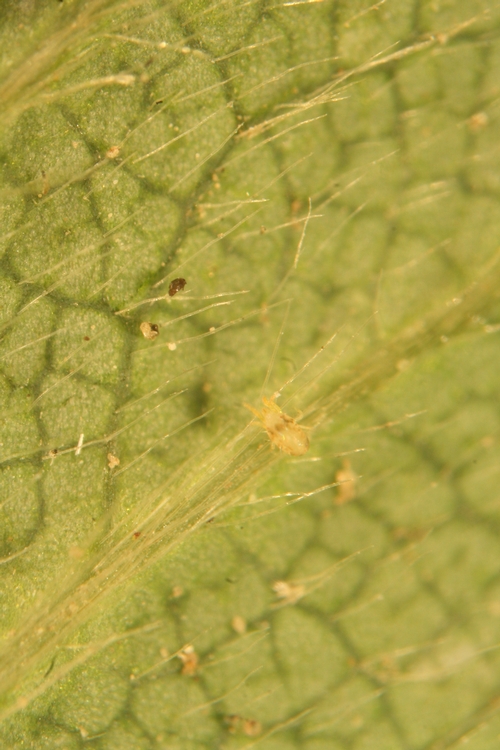2021 Miticide Screen for Lewis Mite and Twospotted Spider Mite
Introduction: As of three years, Lewis mite (Eotetranychus lewisi) has become an issue in Central Coast strawberries, and to some extent on caneberries. A key point to understand is that Lewis mite doesn't necessarily respond to the same control tactics twospotted spider mite does, which has given us some occasion to research how to control it.
The post below will outline a trial just recently finished in a strawberry field just outside of Watsonville. I thank both the PCA and grower who generously allowed me to work in their field, and also were patient as the trial ran its course and potentially damaging populations of mites expanded.
Materials and Methods:
Planting for trial was 'Monterey' variety in the first year of planting and in the early stages of growth at trial commencement. No miticide or insecticide applications were made to trial plot during the course of the study, and on March 14, 2021 an aerial release of 23,000 adults per acre of the predatory mite Phytoseiulus persimilis made. There was P. persimilis already in the trial plots however at the first sampling on January 18, 2021.
Applications were made with a gas powered Maruyama backpack sprayer with a handheld boom configured to cover top and sides of each strawberry bed sprayed. Nozzles were T-Jet 8001 flat fan. First application was done on February 18, 2021 and the second application, in this case only for Vestis and Agrimek, six days later on February 24.
Sampling, begun on January 18 and finished on April 16, 2021 was done approximately every week after the initial miticide application. Sampling was of 10 lower mid-tier leaves (consisting of 3 leaflets), from which numbers of twospotted spider mite adults, Lewis mite adults, P. persimilis adults, and P. persimilis eggs were evaluated directly from the undersides of each leaf. Eggs of twospotted spider mites and Lewis mites are difficult to distinguish from one another and thus were counted together.
Statistical analysis was Duncan's New Multiple Range Test on ARM, version 9.
Table 1 below gives an outline of the treatments and rates
Table 1: List of Treatments
|
Treatment |
Rate/A |
Notes |
|
Oberon |
16 fl oz |
- |
|
Vestis |
13 fl oz |
Applied twice |
|
Aza-Direct |
32 fl oz |
- |
|
Agrimek |
16 fl oz |
Applied twice with 0.1 % Dyne-namic |
|
Untreated check |
- |
- |
|
Nealta |
13.5 fl oz |
- |
Results:
Tabulated results and their statistical evaluation for twospotted spider mites, Lewis mites and their eggs are given below. TSSM stands for "twospotted spider mite", EGG stands for all twospotted and Lewis mite eggs together. Means followed by the same letter do not significantly differ.
P. persimilis data are not included, but available on request.
January 18, 2021 February 23, 2021
| TSSM adult | EGG | Lewis adult | TSSM adult | EGG | Lewis Adult | |
| Oberon | 2.02 a | 15.30 a | 1.87 a | 5.83 a | 37.71 a | 0.86 a |
| Vestis | 7.59 a | 15.48 a | 0.66 a | 1.78 a | 29.71 a | 4.26 a |
| Aza-Direct | 3.10 a | 23.15 a | 1.08 a | 6.49 a | 26.12 a | 2.31 a |
| Agrimek | 11.53 a | 36.81 a | 1.25 a | 10.04 a | 50.37 a | 1.21 a |
| UTC | 3.41 a | 4.24 a | 0.25 a | 2.35 a | 44.76 a | 2.39 a |
| Nealta | 3.89 a | 8.63 a | 2.03 a | 3.68 a | 17.39 a | 1.00 a |
March 4, 2021 March 8, 2021
| TSSM adult | EGG | Lewis adult | TSSM adult | EGG | Lewis adult | |
| Oberon | 19.66 a | 68.28 a | 0.50 a | 24.75 a | 18.34 a | 0.75 a |
| Vestis | 4.47 a | 17.77 a | 0.25 a | 19.00 a | 8.80 a | 0.00 a |
| Aza-Direct | 5.81 a | 51.02 a | 7.25 a | 25.50 a | 16.50 a | 1.25 a |
| Agrimek | 9.27 a | 36.42 a | 1.00 a | 21.50 a | 14.45 a | 0.25 a |
| UTC | 8.15 a | 16.10 a | 1.25 a | 31.50 a | 40.90 a | 7.25 a |
| Nealta | 6.57 a | 19.67 a | 18.50 a | 16.00 a | 22.42 a | 5.00 a |
March 17, 2021 March 24, 2021
| TSSM adult | EGG | Lewis adult | TSSM adult | EGG | Lewis adult | |
| Oberon | 8.19 a | 10.89 a | 1.21 a | 7.22 a | 34.20 a | 0.78 a |
| Vestis | 20.19 a | 16.78 a | 0.86 a | 21.39 a | 52.16 a | 3.64 a |
| Aza-Direct | 22.42 a | 28.82 a | 0.00 a | 25.45 a | 140.72 a | 0.19 a |
| Agrimek | 10.18 a | 13.76 a | 1.11 a | 3.82 a | 16.06 a | 0.41 a |
| UTC | 18.48 a | 28.29 a | 0.41 a | 44.91 a | 147.51 a | 3.21 a |
| Nealta | 23.27 a | 53.19 a | 3.16 a | 14.24 a | 118.40 a | 9.15 a |
March 31, 2021 April 7, 2021
| TSSM adult | EGG | Lewis mite | TSSM adult | EGG | Lewis mite | |
| Oberon | 8.92 a | 84.39 b | 2.41 a | 7.46 c | 31.50 a | 0.41 b |
| Vestis | 10.07 a | 100.38 b | 1.28 a | 54.79 b | 232.00 a | 13.73 a |
| Aza-Direct | 85.01 a | 484.79 a | 11.35 a | 163.03 a | 315.25 a | 17.64 a |
| Agrimek | 4.42 a | 52.04 b | 0.57 a | 74.85 ab | 184.75 a | 1.28 b |
| UTC | 42.22 a | 207.45 ab | 14.34 a | 71.88 ab | 246.00 a | 50.87 a |
| Nealta | 16.99 a | 67.78 b | 2.19 a | 132.11 ab | 167.50 a | 36.48 a |
April 16, 2021
| TSSM adult | EGG | Lewis adult | |
| Oberon | 37.93 c | 44.02 c | 0.68 c |
| Vestis | 28.73 bc | 148.73 abc | 36.35 ab |
| Aza-Direct | 243.40 a | 326.68 a | 25.10 ab |
| Agrimek | 49.88 bc | 126.92 bc | 5.72 bc |
| UTC | 136.77 ab | 265.22 ab | 85.49 a |
| Nealta | 72.11 bc | 200.32 ab | 97.25 a |
Numbers of P. persimilis eggs and adults were low through the most of the trial, ranging between 0 and 1.5 per treatment on average. Only in the last two evaluations on April 7 and April 14, did numbers of eggs and adults of this predator increase to a wider range of less than one up to 15 per treatment. There was never any significant difference between numbers of adults in any of the treatments, and only on the last evaluation was there a significant difference in P. persimilis eggs.
Statistically significant variation between treatments of twospotted and Lewis mites began on March 31, with Aza-Direct and the untreated control being higher than all other treatments. By the last evaluation on April 14, mite eggs were statistically lower in the Agrimek and Oberon treatments than all other treatments other than the Vestis.
On the last sampling date, in the case of Lewis mite adults, Oberon was significantly lower than all other treatments other than the Agrimek, and Agrimek was statistically equivalent to Vestis and Aza-Direct for this mite. This was very similar to the result for twospotted spider mite, with Vestis, Agrimek and Oberon being statistically equivalent and significantly lower than the untreated control.
Discussion:
Growers, farm managers and PCA's should draw from this that Agrimek, Oberon and to some extent Vestis are offering good solutions to our current Lewis mite issue in strawberry. While the lack of compatibility of Agrimek and Oberon is known for P. persimilis, it is not yet well known for Vestis. However, that populations of these predators, albeit quite low in the early phase of this trial, did not vary statistically from other treatments indicates that perhaps this material is not overwhelmingly harmful to them.

A strawberry plant heavily infested with Lewis mite in 2020. Shoe is my own. Photo by Mark Bolda, UCCE.

Lewis mite. Note spotting down the sides of the body, also crab leg posture of the legs. Photo by Mark Bolda, UCCE.

